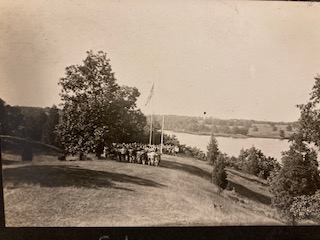Camp Pleasant, as Juniper Knoll (JK) was originally called, opened for the summer on June 24, 1924. Two units of tents served 620 Girl Scouts before the close of the summer season. A contest was held to find a name for the camp with “heart and soul,” and the Camp Juniper Knoll opened the next summer with six new tents as a part of a third unit. The units were known as Sunny Ridge, Sleepy Hollow, and Frontier. A new range, sanitation system, and wooden tent floors were added to improve camp conditions. The cook stove and ovens were wood and coal burning, with the fires sometimes started by using dried corn cobs. Fresh milk and eggs came every day from a nearby farm. All baked goods were made fresh at camp.
Ceremonies and traditions were very popular at Juniper Knoll. Many of the traditions evolved from the unit themes, others had universal appeal. New units were added over the years as additional tents were purchased. Girl Scouts could be a pirate in Treasure Island, a Scotsman in plaid from Bonnie Highlands, or a pioneer in Frontier for their two-week stay at summer camp. The Shining Waters unit later became Shongela. Greenwood was a new unit with the Sherwood Forest and Robin Hood tradition. Greenwood was a unit that was fairly modern, while Frontier remained more primitive.
Early in Juniper Knoll’s history, a young man named Johnny Weissmuller spent time at camp as a lifeguard one summer. He would go on to win five gold medals for swimming and one bronze medal for water polo at the Olympics. His talents in the water and his good looks also landed him the starring role in 12 Tarzan movies during the 1930’s and 1940’s.
By the late 1930’s a number of new camp structures had been built. The Book Nest, a library, provided donated books for free-time reading in the sun. A lodge was built at the far end of camp. When the Treasure Island unit had to close because of erosion, the tents were combined with Lone Cedar and renamed Clippership to keep some of the sea-faring flavor that had made it so popular. The new lodge was close by, so it was named Clipper’s Cabin. A camp gong was hung in the clearing near Book Nest. The gong was used to call Girl Scouts to meals, to announce the time, or to invite the camp to a “Scout’s Own.” In 1939, electricity came to Juniper Knoll.
A few of the old JK traditions died in the 1950’s. Gone were the wood-burning stoves and the old milk cooler. In addition to a gas stove and refrigerator, a dishwasher updated the camp. In 1952, the council purchased 118 acres of land adjoining JK to the west. The original plan was to make the property a separate camp for younger Girl Scouts. Through a contest, the name Acorn Hill was selected for the new camp. The first unit built at Acorn Hill was Citadel. In 1955 the JK lakefront was closed due to erosion and a new swimming area was built on the Acorn Hill site, and Acorn Hill became a part of Juniper Knoll. Another addition to the camp was the roofless camper shower house. The idea was that sun could get to all areas of the showers to prevent mildew and rot.
A modern design dining hall for 300, named Bensinger Lodge, was donated to Juniper Knoll in 1962. The purchase of 35 additional acres with a caretaker’s house completed the Juniper Knoll property. The Boat House was built in 1963 and the Wilderness Unit and Unit House were built in 1967. The units were Chalet, Citadel, Clippership, Frontier, Greenwood, Gypsy Hollow, Nataqua, Shongela, Voyageur, and Wilderness, and each could house at least 24 campers. Development plans called for the demolition of the original Old Lodge mess hall-kitchen-office building. It was decided by the Girl Scouts of Chicago to demolish just the office and kitchen, and to build a new office and attach it to the mess hall. The old exterior was remodeled, but the inside was left as it had been since 1924. The Old Lodge was renamed Low Lodge in honor of Juliette Gordon Low, who was rumored to have visited the camp early in it’s history. The Health Center was built in 1978, the newest building on site until the completion of Promise Lodge in 2001 on the site of the former Voyageur unit.
Due to structural damage sustained from harsh winter weather, Bensinger Lodge was demolished and, beginning in 2013, campers dined in an ‘open-air dining hall’ outside of Promise Lodge until construction of the new dining hall was completed in 2016. By this time, there were seven camper units, with platform tents in Chalet, Citadel, Clippership, Greenwood, and Wilderness, and yurts in Shongela. In 2023, new tabins were donated to replace the platform tents in Chalet.
Times have changed the way Girl Scouts camp at Juniper Knoll, but not the feeling Girl Scouts get from discovering and sharing. Campers may keep their soap and toothpaste in plastic airtight containers instead of hoisting them on ropes strung across tree branches to keep animals from eating them. And maybe it’s a flush toilet instead of a pit latrine, but it’s still a Girl Scout’s own world, where she can escape from the city, learn, grow, and feel the love of all the Girl Scouts who have camped there before her.

















